 |
CHAPTER IX
THE LATER RULERS OF LAGASH
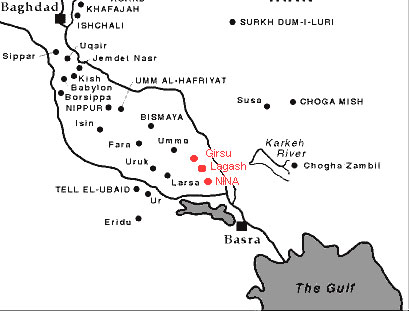 |
WE have
seen that the Dynasty of Akkad marks the culminating point attained by the
races of Sumer and Akkad during the earlier periods of their history. It is
true that the kings of this period owed much to their immediate predecessors,
but they added to and improved their inheritance. Through long centuries of
slow development the village community had gradually been transformed into the
city-state, and this institution had flourished and had in its turn decayed
before the centralizing influence of the kingdoms of Sumer and Kish. It was on
the ruins of the latter monarchy that Shar-Gani-sharri founded his empire,
which differed from that of Kish in its extent, rather than in the principles
of its formation. A similarly close connection can be traced between the cultural
remains of the successive periods with which we have hitherto been dealing. The
rude, though vigorous, artistic efforts of the earlier Sumerians furnished the
models upon which the immigrant Semites of Northern Babylonia improved. In the
sculpture of Kish and upon cylinder-seals of that period we see the transition
between the two styles, when the aim at a naturalistic treatment sometimes
produced awkward and grotesque results. The full attainment of this aim under
the patronage of the Akkadian kings gives their epoch an interest and an
importance, which, from their empire alone, it would not perhaps have enjoyed.
| Late Akkadian Red Jasper Cylinder Seal |
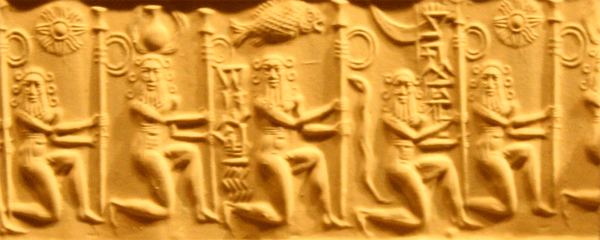 |
While the
earlier ages of Babylonian history afford a striking picture of gradual growth
and development, the
periods succeeding the Dynasty of Akkad ate marked by a certain retrograde
movement, or reversion to earlier ideals. The stimulus, which produced the
empire and the art of Akkad, may be traced to the influx of fresh racial
elements into Northern Babylonia and their fusion with the older and more
highly cultured elements in the south. When the impulse was exhausted and the
dynasties to which it had given rise had run their course, little further
development along these lines took place. Both in art and politics a Sumerian
reaction followed the period of Semitic power, and the establishment of the
Dynasty of Ur was significant of more than a shifting of political influence
southwards. It would appear that a systematic attempt was made to return to
the earlier standards. But the influence of Akkad and her monarchs, though
deliberately ignored and combated, was far from ineffective. As the sculptures
of Gudea owe much to the period of Naram-Sin, so the empire of Dungi was
inevitably influenced by Shar-Gani-sharri's conquests. There was no sudden
arrest either of the political or of the cultural development of the country. A
recovery of power by the Sumerians merely changed the direction in which
further development was to take place. Although, when viewed from a general
standpoint, there is no break of continuity between the epoch of Akkad and that
of Ur, there is some lack of information with regard to events in the
intervening period. There is every indication that between the reign of
Naram-Sin and that of Ur-Engur, the founder of the Dynasty of Ur, we have to
count in generations rather than in centuries, but the total length of the
period is still unknown. The close of the Dynasty of Akkad, as we have already
seen, is wrapped in mystery, but the gap in our knowledge may fortunately to
some extent be bridged. At this point the city of Lagash once more comes to our
assistance, and, by supplying the names of a number of her patesis, enables us
to arrange a sequence of rulers, and thereby to form some estimate of the
length of the period involved.
It will
be remembered that under Shar-Gani-sharri and Naram-Sin a
certain
Lugal-ushumgal (ca. 2230-2200 BC) was patesi of Lagash,
and that the impressions of his seals have been recovered which
he employed
during the reigns of these two monarchs. The names of three
other patesis
of Lagash are known, who must also be assigned to the period of
the Dynasty of
Akkad, since they are mentioned upon tablets of that date. These
are Ur-Babbar, Ur-E, and Lugal-bur; the first of these appears to have
been the contemporary
of Naram-Sin, and in that case he must have followed
Lugal-ushumgal. As to
Ur-E and Lugal-bur, we have no information beyond the fact that
they lived
during the period of the kings of Akkad. A further group of
tablets found at
Tello, differentiated in type from those of the Dynasty of Akkad
on the one
hand, and on the other from tablets of the Dynasty of Ur,
furnishes us with the
names of other patesis to be set in the period before the rise
of Ur-Engur.
Three of these, Basha-mama, Ur-mama, and Ug-me, were probably
anterior to
Ur-Bau, who has left us ample proof of his building activity at
Lagash. We
possess a tablet dated in the accession year of Ur- mama, and
another dated
during the patesiate of Ug-me, in the year of the installation
of the high
priest in Nina. A sealing of this last patesi's reign has also
been found,
which supports the attribution of this group of tablets to the
period between
the Sargonic era and that of Ur. The subject of the engraving
upon the seal is
the adoration of a deity, a scene of very common occurrence
during the later
period; but by its style and treatment the work vividly recalls
that of the
epoch of Shar-Gani-sharri and Naram-Sin. On the strength of this
evidence it
has been argued that Ug-me's period was not far from that of
Lugal-ushumgal,
Ur-E, and Lugal-bur.
One of
the documents of this period is dated during the patesiate of Ur-Bau himself,
in the year in which he undertook certain extensive works of irrigation, while
others are dated in the year of Ur-gar's accession, and in that which followed
the accession of Nammakhni. From other evidence we know that Nammakhni was
Ur-Bau's son-in-law, since he espoused Ningandu, Ur- Bau's daughter, and
secured through her his title to the throne. Ur-gar, too, must belong to the
generation following Ur-Bau, since a female statue has been found at Tello,
which was dedicated to some deity by a daughter of Ur-Bau on behalf of her own
life and that of Ur-gar, the patesi. Tablets are also dated in the
accession-years of Ka-azag, Galu-Bau, and Galu-Gula, and their contents
furnish indications that they date from about the same time. Ur-Ninsun, whose
name and title occur on the fragment of a bowl very similar to that employed by
Nammakhni's wife, is not mentioned on the tablets, but several are dated in
the reigns of Gudea and of his son Ur-Ningirsu. Now, in the reign of Dungi,
the son of Ur-Engur, there lived a high priest of the goddess Nina named
Ur-Ningirsu; and, if we may identify this priestly official with the patesi of
that name, as is very probable, we obtain a definite point of contact between
the later history of Lagash and that of Ur. But even if the synchronism between
Ur-Ningirsu and Dungi be regarded as non-proven, there
is no
doubt that no long interval separated Gudea's reign from the Dynasty of Ur. The
character of the art and the style of writing which we find in Lagash at this
time are so similar to those of Ur, that the one period must have followed the
other without a break. A striking example of the resemblance which existed in
the artistic productions of the two cities at this time is afforded by the
votive copper cones, or nails, of Gudea and Dungi, surmounted by the figures of
a bull couchant. A glance will show the slight changes
in the form and treatment of the subject which have been introduced by
the metal-workers of Dungi's reign.
From
the brief summary given in the preceding paragraphs it will have been
noted that we have recovered the names of some twelve patesis of Lagash,
who may be assigned to the period between the dynasties of Akkad and
Ur. Of these twelve names no less than eleven occur upon a group of
tablets, which were found together at Tello, and are marked out by their
shape and contents as belonging to a single period. The tablets
themselves are of unbaked clay, and they form a transition
between the types of
Akkad and Ur. In the last of the reigns mentioned it is probable
that we may
trace a synchronism with the Dynasty of Ur, and, although no
actual point of
contact can yet be established with the Dynasty of Akkad, such
evidence as that
furnished by Ug-me's sealing suggests that no considerable lapse
of time can
have taken place. That these twelve patesis were the only ones
who ruled at
Lagash during this interval is improbable, and at any time the
names of other
rulers may be recovered. But it is certain the reigns of many of
these patesis
were extremely brief, and that we have not to do with a single
dynasty, firmly
established throughout the whole period, whose separate members,
after their
accession, each held the throne for the term of his natural
life. We have
definite proof that several of the patesis, such as Ka-azag,
Galu-Bau, and
Galu-Gula, ruled only for a few years, and it would seem that at
certain points
during this period a change of rulers took place in Lagash with
considerable
frequency.
| TO NINGIRSU, MIGHTY WARRIOR OF ENLIL,
GUDEA RULER OF LAGASH MADE IT SPLENDID FOR HIM AND BUILT FOR HIM THE
TEMPLE OF THE SHINING IMDUGUD BIRD AND RESTORED IT |
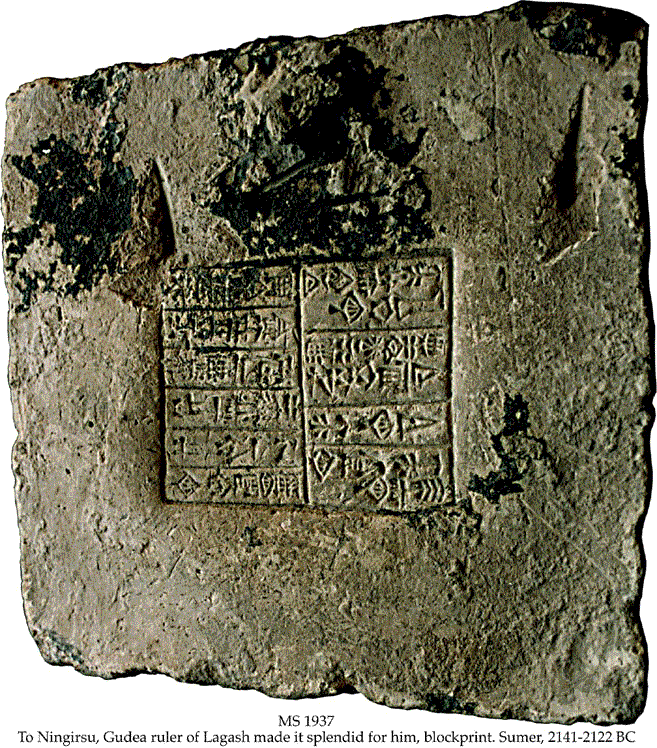 |
The
employment of the title of patesi, and the total absence of that
of "king" at this time, suggests that Lagash had not succeeded in
establishing her
independence, and still owed allegiance to some alien dynasty.
It is in
accordance with this view that the dates inscribed upon the
commercial tablets
do not refer to events of a military character. We may conclude
that, at any
rate until the reign of Gudea, Lagash and her rulers were not
concerned to
enforce their authority over other cities, nor to defend their
own border from
attack. The existence of a more powerful city, claiming the
hegemony in
Babylonia, would account for the absence of military enterprise
reflected in
the date- formulas and in the foundation-records of the time.
For such a city,
while guaranteeing the integrity of each of her tributary
states, would have
resented the inauguration of an ambitious policy by any one of
them. On the
other hand, the purely local character of the events
commemorated in the
date-formulas is no less significant. These are without
exception drawn
from the
local history of Lagash, and betray no evidence of the authority exercised by a
foreign suzerain. It is therefore probable that during the greater part of this
period Lagash enjoyed a considerable measure of autonomy, and that such bonds
as may have united her to any central administration were far less tightly
drawn than at the time of Shar-Gani-sharri and Naram-Sin. Like Lagash, her old
rival Umma seems to have survived as a patesiate under the later Semitic rulers
in the north, and it is probably to this time that we may assign Galu-Babbar,
the patesi of that city, three of whose votive cones are preserved in the
British Museum. During the earlier part of this period Lagash presents the
picture of a compact and peaceful state, content to develop her own resources.
A considerable increase of power is noticeable in the reign of Gudea, the most
famous ruler of the period, who, though still retaining the title of patesi,
must be regarded as practically an independent sovereign, since he was strong enough
to undertake a successful campaign in Elam, and imported his building
materials from Arabia and the Syrian coast.
CLAY CONE BEARING VOTIVE INSCRIPTIONS OF THE PATESI UR-BAU. |
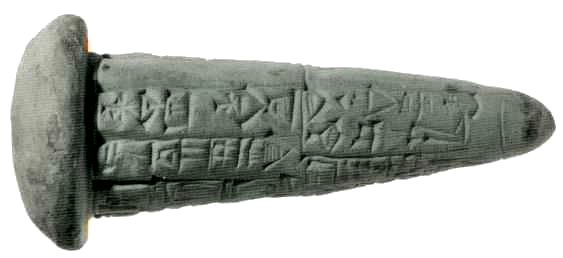 |
With the
exception of Gudea, the only ruler of this period who has left us any
considerable records or remains is Ur-Bau (c. 2164-2144 BC), the predecessor of Nammakhni and
Ur-gar upon the throne of Lagash. We possess a small diorite statue of this
ruler, which, like most of those found at Tello, is without its head. It is a
standing figure, and its squat and conventional proportions suffice to show that
it must date from a rather earlier period than the larger and finer statues of
Gudea, which are fashioned from the same hard material. Gudea definitely states
that he fetched the diorite for his series of large statues from Magan, but
Ur-Bau makes no such boast; and, although it is clear that his stone must have
come from the same quarries, we may probably conclude that the small block he
employed for his figure had not been procured as the result of a special
expedition. In fact, such records as he has left us portray him as devoting all
his energies to the
building
of temples within the different quarters of his city.
His chief
care appears to have been the rebuilding, upon a new and enlarged site, of
E-ninnu, the great temple of Ningirsu at Lagash, in which he placed the statue
of himself that has been recovered. Little of this temple now remains in the
mounds of Tello, beyond a wall the lower part of which was found still standing
under the south-east corner of the later palace erected in the second century
BC. In addition to the rebuilding of the temple of the city-god, Ur-Bau
records that he erected three temples in Girsu in honour of the godĀdesses
Ninkharsag and Geshtin-anna, and of Enki, "the king of Eridu". In
Uru-azagga he built a temple for the goddess Bau, and in Uru, another quarter
of the city, he constructed a shrine in honour of Ninni, or Nin-azag-nun, the goddess
Ishtar. Other deities honoured in a similar way by Ur-Bau were Nindar, Ninmar,
and Ninagal, the last of whom stood in the mystical relation of mother to the
patesi. Attached to E-ninnu he also built a "House of the Asses" in
honour of Esignun, the deity whose duty it was to tend the sacred asses of
Ningirsu.
Ur-Bau
may probably be regarded as representative of the earlier patesis of this
epoch, who, while acting with freedom and independence within the limits of
their own state, refrained from embarking on any policy of conquest or
expansion. With the accession of Gudea a distinct change is noticeable in the
circumstances of Lagash. Like his predecessors, he devoted himself to the
building of temples, but his work was undertaken on a wider and more sumptuous
scale. Of all the kings and patesis of Lagash, he is the one under whom the
city appears to have attained its greatest material prosperity, which found
its expression in a lavish architectural display. Although not much of his
great temple of E-ninnu still survives at Tello, his monuments are more
numerous than all the others that have been recovered on that site. Moreover, the texts engraved
upon his
statues, and inscribed upon the great clay cylinders which he buried as
foundation-records in the structure of E-ninnu, are composed in a florid style
and form a striking contrast to the dry votive formulae employed by the
majority of his predecessors. The cylinder-inscriptions especially are cast in
the form of a picturesque narrative, adorned with striking similes and a wealth
of detailed description such as are not found in the texts of any other period.
In fact, Gudea's records appear to have been inspired by the novelty and
magnitude of his architectural constructions and the variety of sacred ornament
with which they were enriched.
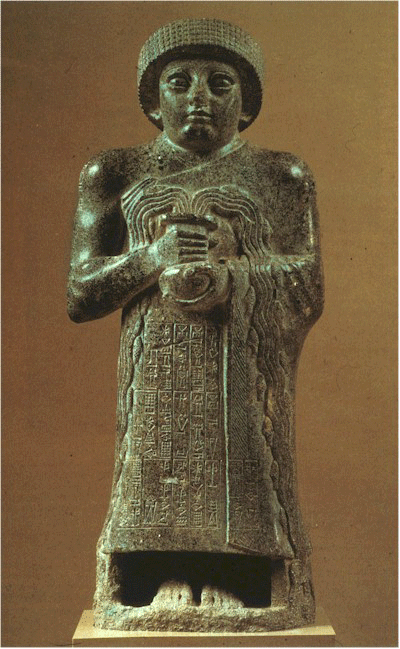 |
We have
no information as to the events which led to his accession, beyond the negative
evidence afforded by the complete absence of any genealogy from his
inscriptions. Like Ur-Bau, Gudea does not name his father, and it is possible
that he was a man of obscure or doubtful birth. The energy which he displayed
as patesi is sufficient to account for his rise to power, and the success which
attended his period of rule may be held to have amply justified a break in the
succession. Another problem suggested by a study of his texts concerns the
source of the wealth which enabled him to undertake the rebuilding and
refurnishing of the temples of Lagash upon so elaborate a scale. The cause of
such activity we should naturally seek in the booty obtained during a number of
successful campaigns, but throughout the whole of his inscriptions we have
only a single reference to an act of war. On the statue of himself in the
character of an architect, holding the plan of E-ninnu upon his knees, he gives
in some detail an account of the distant regions whence he obtained the
materials for the construction of Ningirsu's temple. At the close of this list
of places and their products, as though it formed a continuation of his
narrative, he adds the record that he smote with his weapons the town of Anshan
in Elam and offered its booty to Ningirsu. This is the only mention of a
victory that occurs in Gudea's inscriptions, and, although in itself it proves
that he was sufficiently independent to carry on a war in
Elam on
his own account, it does not throw light upon the other causes of his success.
The
absence of military records from Gudea's texts is rendered the
more striking,
when we read the names of the countries he laid under
contribution for the
materials employed in the building of E-ninnu. The fullest
geographical list is
that given on the statue of the architect with the plan, and,
although
unfortunately some of the places mentioned have still to be
identified, the
text itself furnishes sufficient information to demonstrate the
wide area of
his operations. Gudea here tells us that from Mount Amanus, the
mountain of
cedars, he fetched beams of cedar-wood measuring fifty and even
sixty cubits in
length, and he also brought down from the mountain logs of
urkarinnu-wood five-and-twenty cubits long. From the town of Ursu in the
mountain of Ibla he
brought zabalu-wood, great beams of ashukhu-wood and
plane-trees. From Umanu, a
mountain of Menua, and from Basalla, a mountain of Amurru, he
obtained great
blocks of stone and made stelae from them, which he set up in
the court of
E-ninnu. From Tidanu, another mountain of Amurru, he brought
pieces of marble,
and from Kagalad, a mountain of Kimash, he extracted copper,
which he tells us
he used in making a great mace-head. From the mountains of
Melukhkha he brought
ushu-wood, which he employed in the construction of the temple,
and he fetched
gold-dust from the mountain of Khakhu and with it he gilded a
mace-head carved
with the heads of three lions. In Gubin, the mountain of
khuluppu-wood, he
felled khuluppu-trees; from Madga he obtained asphalt, which he
used in making
the platĀform of E-ninnu; and from the mountain of Barshib he
brought down
blocks of nalua-stone, which he loaded into great boats and so
carried them to
Lagash in order to strengthen the base of the temple.
The above
list of places makes it clear that Gudea obtained his wood and stone from
mountains on the coast of Syria and in Arabia, and his copper from mines in
Elam. On the first of his cylinders he also states that the Elamite came from
Elam and the man of Susa
from
Susa, presumably to take part as skilled craftsmen in the construction of the
temple. In this account he does not mention the names of so many places as in
the statue-inscription, but he adds some picturesque details with regard to the
difficulties of transport he encountered. Thus he records that into the
mountain of cedars, where no man before had penetrated, he cut a road for
bringing down the cedars and beams of other precious woods. He also made roads
into the mountains where he quarried stone, and, in addition to gold and
copper, he states that he obtained silver also in the mountains. The stone he
transported by water, and he adds that the ships bringing bitumen and plaster
from Madga were loaded as though they were barges carrying grain.
A third
passage in Gudea's texts, referring to the transport of materials from a
distance, occurs upon the colossal statue of himself which he erected in
E-ninnu. Here he states that Magan, Melukhkha, Gubi, and Dilmun collected
wood, and that ships loaded with wood of all kinds came to the port of Lagash.
Moreover, on eight out of his eleven statues he records that the diorite, from
which he fashioned them, was brought from Magan. In his search for building
materials, he asserts that he journeyed from the lower country to the upper
country; and, when summarizing the area over which he and his agents ranged, he
adopts an ancient formula, and states that Ningirsu, his beloved king, opened
the ways for him from the Upper to the Lower Sea, that is to say, from the
Mediterranean to the Persian Gulf.
The
enumeration of these distant countries, and Gudea's boastful reference to the
Upper and the Lower Sea, might, perhaps, at first sight be regarded as
constituting a claim to an empire as extensive as that of Shar-Gani-sharri and
Naram-Sin. But it is a remarkable fact that, with the exception of Lagash and
her constituent townships, Gudea's texts make no allusion to cities or
districts situated within the limits of Sumer and Akkad. Even the names of
neighbouring great towns, such as Ur, Erech, and Larsa, are not once cited,
and it can only be inferred that they enjoyed with Lagash an equal measure of
independence. But if Gudea's authority did not extend over neighbouring cities
and districts within his own country, we can hardly conclude that he exercised
an effective control over more distant regions. In fact, we must treat his
references to foreign lands as evidence of commercial, not of political,
expansion.
Gudea's
reign may be regarded as marking a revival of Sumerian prosperity, consequent on
the decay of Semitic influence and power in the north. The fact that he was
able to import his wood and stone from Syria, and float it unmolested down the
Euphrates, argues a considerable weakening of the northern cities. Whether
Akkad, or some other city, still claimed a nominal suzerainty over the southern
districts it is impossible to say, but it is at least clear that in the reign
of Gudea no such claim was either recognized or enforced. We may suppose that
Lagash and the other great cities in the south, relieved from the burden of
Semitic domination, enjoyed a period of peace and tranquillity, which each city
employed for the development of her material resources. The city of Ur was
soon to bring this state of affairs to a close, by claiming the hegemony among
the southern cities and founding the kingdom of Sumer and Akkad by force of
arms. But during Gudea's reign Ur appears to have made no movement, and Lagash
and the other great cities of the land may be pictured as maintaining
commercial relations with each other, unhampered by the striving of any one of
them for political supremacy.
It is
possible that we may trace the unparalleled building activity, which
characterized Gudea's reign, in part to a development in the art of building,
which appears to have taken place at about this period. It has been suggested
that both Gudea and Ur-Engur, the founder of the Dynasty of Ur, participated in
the same great architectural movement, and proof of this has been seen in
their common employment of the smaller square brick, measuring from about
twelve to thirteen inches, which was more easy to handle than
the
larger bricks employed by Ur-Bau and at the time of the Dynasty of Akkad. The
inherent advantages of this form of brick are attested by its retention, with
but slight variations, down to the end of the Babylonian empire. That Gudea
himself set considerable store by the form of the bricks which he employed
would seem to follow from the passage in his first cylinder-inscription, where
he describes the ceremonies with which he inaugurated their manufacture,
including the offer of sacrifices and the pouring of a libation into the sacred
mould. The use of an improved material may well have incited him to rebuild
the greater number of the sanctuaries in Lagash on their ancient sites, but
enlarged and beautified in accordance with the new architectural ideas. From
another passage in his texts it would seem that he definitely claimed to have
inaugurated a novel form of building, or decoration, such as no patesi before
him had employed. The meaning of the phrase is not quite certain, but it may,
perhaps, have reference to the sculptured reliefs with which he adorned
E-ninnu. It may also refer to the use of raised pilasters for the adornment of
facades and external walls, a form that is characteristic of later Babylonian
architecture, but is not found in the remains of buildings at Lagash before
Gudea's time.
| GUDEA CYLINDER |
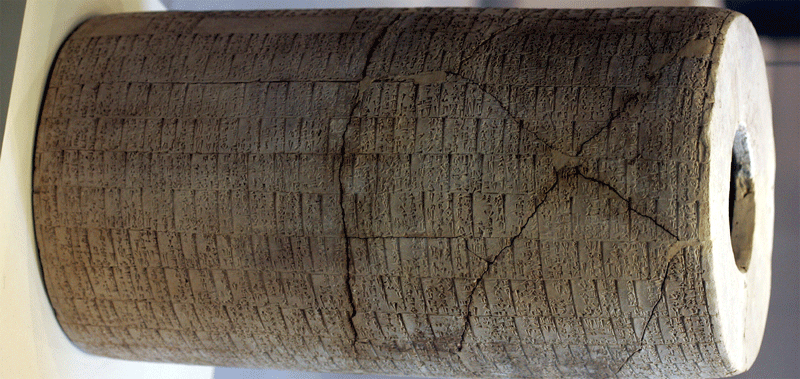 |
In
addition to E-ninnu, the great temple of the city-god Ningirsu, Gudea records
that he rebuilt the shrines dedicated to Bau and Ninkharsag, and E-anna, the
temple of the goddess Ninni, and he erected temples to Galalim and Dunshagga,
two of Ningirsu's sons. In Uru-azagga he rebuilt Gatumdug's temple, and in
Girsu three temples to Nindub, Meslamtaea, and Nindar, the last of whom was
associated with the goddess Nina, in whose honour he made a sumptuous throne.
In Girsu, too, he built a temple to Ningishzida, his patron god, whom he
appears to have introduced at this time into the pantheon of Lagash. One of the
most novel of his reconstructions was the E-pa, the temple of the seven zones,
which he erected for Ningirsu. Gudea's building probably took the form of a
tower in seven stages, a
true
ziggurat, which may be compared with those of Ur-Engur. But the work on which he
most prided himself was the rebuilding of E-ninnu, and to this he devoted all
the resources of his city. From a study of the remains of this temple that were
uncovered at Tello by M. de Sarzec, it would appear that Gudea surrounded the
site of Ur-Bau's earlier building with an enclosure, of which a gateway and a
tower, decorated with pilasters in relief, are all that remains. These were
incorporated in the structure of the late palace at Tello, a great part of
which was built with bricks from the ancient temple. It is difficult to
determine the relation of these slight remains at Tello, either to the building
described by Gudea himself, or to the plan of a fortified enclosure which one
of the statues of Gudea, as an architect, holds upon his knees. That the plan
was intended, at any rate, for a portion of the temple is clear from the
inscription, to the effect that Gudea prepared the statue for E-ninnu, which he
had just completed.
The
detailed account of the building of this temple, which Gudea has left us,
affords a very vivid picture of the religious life of the Sumerians at this
epoch, and of the elaborate ritual with which they clothed the cult and worship
of their gods. The record is given upon
two huge
cylinders of clay, one of which was inscribed while the work of building was
still in progress, and the other after the building and decoration of the
temple had been completed, and Ningirsu had been installed within his shrine.
They were afterwards buried as foundation-records in the structure of the
temple itself, and so have survived in a wonderfully well-preserved condition,
and were recovered during the French excavations at Tello. From the first of
the cylinders we learn that Gudea decided to rebuild the temple of the city-god
in consequence of a prolonged drought, which was naturally ascribed to the
anger of the gods. The water in the rivers and canals had fallen, the crops had
suffered, and the land was threatened with famine, when one night the patesi
had a vision, by means of which the gods communicated their orders to him.
Gudea
tells us that he was troubled because he could not interpret the meaning of the
dream, and it was only after he had sought and received encouragement from
Ningirsu and Gatumdug that he betook himself to the temple of Nina, the goddess
who divines the secrets of the gods. From her he learnt that the deities who
had appeared to him in his vision had been Ningirsu, the god of his city,
Ningishzida, his patron deity, his sister Nidaba, and Nindub, and that certain
words he had heard uttered were an order that he should build E-ninnu. He had
beheld Nindub drawing a plan upon a tablet of lapis-lazuli, and this Nina
explained was the plan of the temple he should build. Nina added instructions
of her own as to the gifts and offerings the patesi was to make to Ningirsu,
whose assistance she promised him in the carrying out of the work. Gudea then
describes in detail how he obtained from Ningirsu himself a sign that it was
truly the will of the gods that he should build the temple, and how, having
consulted the omens and found them favourable, he proceeded to purify the city
by special rites. In the course of this
work of
preparation he drove out the wizards and sorcerers from Lagash, and kindled a
fire of cedar and other aromatic woods to make a sweet savour for the gods;
and, after completing the purification of the city, he consecrated the
surrounding districts, the sacred cedar-groves, and the herds and cattle
belonging to the temple. He then tells us how he fetched the materials for the
temple from distant lands, and inaugurated the manufacture of the bricks with
solemn rites and ceremonies.
We are
not here concerned with Gudea's elaborate description of the new temple, and
of the sumptuous furniture, the sacred emblems, and the votive objects with
which he enriched its numerous courts and shrines. A large part of the first
cylinder is devoted to this subject, and the second cylinder gives an equally
elaborate account of the removal of the god Ningirsu from his old shrine and
his installation in the new one that had been prepared for him. This event
took place on a duly appointed day in the new year, after the city and its
inhabitants had undergone a second course of purification. Upon his transfer to
his new abode Ningirsu was accompanied by his wife Bau, his sons, and his seven
virgin daughters, and the numerous attendant deities who formed the members of
his household. These included Galalim, his son, whose special duty it was to
guard the throne and place the sceptre in the hands of the reigning patesi;
Dunshagga, Ningirsu's water- bearer; Lugal-kurdub, his leader in battle;
Lugal-sisa, his counsellor and chamberlain; Shakanshabar, his grand vizir;
Uri-zi, the keeper of his harim; Ensignun, who tended his asses and drove his
chariot; and Enlulim, the shepherd of his kids. Other deities who accompanied
Ningirsu were his musician and flute-player, his singer, the cultivator of his
lands, who looked after the machines for irrigation, the guardian of the sacred
fish-ponds, the inspector of his birds and cattle, and the god who
superintended the construction of houses within the city and fortresses upon
the city-wall. All these deities were installed in special shrines within
E-ninnu, that they might be near Ningirsu and ready at any moment to carry out
his orders.
The
important place which ritual and worship occupied in the national life of the
Sumerians is well illustrated by these records of the building and
consecration of a single temple. Gudea's work may have been far more elaborate
than that of his predecessors, but the general features of his plan, and the
ceremonies and rites which he employed, were doubtless fixed and sanctified by
long tradition. His description of Ningirsu's entourage proves that the
Sumerian city-god was endowed with all the attributes and enjoyed all the
privileges of the patesi himself, his human counterpart and representative. His
temple was an elaborate structure, which formed the true dwelling-place of its
owner and his divine household; and it included lodgings for the priests, treasure-chambers,
store-houses, and granaries, and pens and stabling for the kids, sheep and
cattle destined for sacrifice. It is interesting to note that in the course of
building Gudea came across a stele of Lugal-kisalsi, an earlier king of Erech
and Ur. From the name which he gave it we may infer that he found it in
Girnun, which was probably one of the shrines or chapels attached to E-ninnu;
and he carefully preserved it and erected it in the forecourt of the temple.
In the respect which he showed for this earlier record, he acted as Nabonidus
did at a later day, when he came across the foundation-inscriptions of
Naram-Sin and Shagarakti-Buriash in the course of his rebuilding of E-babbar
and E-ulmash, the temples of Shamash and of the goddess Anunitu.
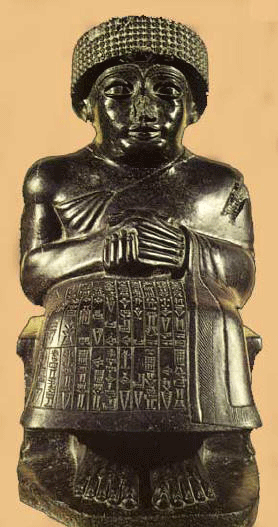 |
Of the
article productions of Gudea's period the most striking that have come down to
us are the series of diorite statues of himself, which were found together in
the late palace at Tello. From the inscriptions upon them it is clear that they
were originally prepared by the patesi for dedication in the principal temples
of Lagash, which he either founded or rebuilt. Three were installed in E-ninnu,
of which one is the statue of the architect with the plan, and another, a
seated figure, is the only one of the series of colossal proportions. Three
more were made for the temple of Bau, and others for Ninni's temple E-anna, and
the temples of the goddesses Gatumdug and Ninkharsag. The small seated figure,
destined for the temple of Ningishzida, is the only one of which we possess the
head, for this was discovered by Commandant Cros during the more recent
diggings at Tello, and was fitted by M. Heuzey to the body of the figure which
had been preserved in the Louvre for many years. From the photographic reproduction
it will be seen that the size of the head is considerably out of proportion to
that of the body ; and it must be admitted that even the larger statues are not
all of equal merit. While in some of them the stiffness of archaic convention
is still apparent, others, such as the seated statues for E-ninnu and that of
the architect with the rule from the temple of Gatumdug, are distinguished by
a fine naturalism and a true sense of proportion.
Some
interesting variations of treatment may also be noted in two of the standing
statues from the temple of Bau. One of these is narrow in the shoulders and
slender of form, and is in striking contrast to the other, which presents the
figure of a strong and broad-shouldered man. It would seem that the statues
were sculptured at different periods of Gudea's life, and from the changes
observable we may infer that he ascended the throne while still a young man and
that his reign must have been a long one. The diorite which he used for them
was very highly prized for its durability and beauty, and the large block that
was required for his
colossal
figure appears, when the carving was completed, to have been regarded as far
more precious than lapis-lazuli, silver, and other metals. Certainly the
preparation of so hard a stone presented more difficulty than that of any other
material, and that Gudea's sculptors should have learnt to deal successfully
with such large masses of it argues a considerable advance in the development
of their art.
The small
copper figures of a kneeling god grasping a cone are also characteristic of
Gudea's period, but in design and workmanship they are surpassed by the similar
votive figure which dates from Ur-Bau's reign. A fine example of carving in
relief is furnished by the oval panel, in which Gudea is represented as being
led into the presence of his god; a similar scene of worship, though on a
smaller scale, is engraved upon his cylinder-seal. A happy example of carving
in the round, as exhibited by smaller objects of this period, is his small
mace-head of breccia decorated with the heads of three lions. In design this
clearly resembles the mace-head referred to on one of the statues from E-ninnu,
though, unlike it, the small mace-head was probably not gilded, since the
inscription upon it mentions the mountain in Syria whence the breccia was
obtained. But other carved objects of stone that have been recovered may well
have been enriched in that way, and to their underlying material they probably
owe their preservation. The precious metal may have been stripped from these
and the stone cores thrown aside; but similar work in solid gold or silver
would scarcely have escaped the plunderer's hands.
With the
exception of the period of drought, in consequence of which Gudea decided to
rebuild Ningirsu's temple, it is probable that during the greater part of his
reign the state of Lagash enjoyed unparalleled abundance, such as is said to
have followed the completion of that work. The date-formula for one of his
years of rule takes its title from the cutting of a new canal which he named
Ningirsu-ushumgal, and there is no doubt that he kept the elaborate system
of irrigation, by which Lagash and her territories were supplied with water, in
a perfect state of repair. Evidence of the plentiful supplies which the
temple-lands produced may be seen in the increase of the regular offerings
decreed by Gudea. On New Year's day, for instance, at the feast of Bau, after
he had rebuilt her temple, he added to the marriage-gifts which were her due,
consisting of oxen, sheep, lambs, baskets of dates, pots of butter, figs,
cakes, birds, fish, and precious woods, etc. He also records special offerings
of clothing and wool which he made to her, and of sacrificial beasts to
Ningirsu and the goddess Nina. For the new temple of Gatumdug he mentions the
gift of herds of cattle and flocks of sheep, together with their herdsmen and
shepherds, and of irrigation-oxen and their keepers for the sacred lands of
E-ninnu. Such references point to an increase in the revenues of the state,
and we may infer that the people of Lagash shared the prosperity of their patesi and his priesthood.
While
Gudea devoted himself
to the service of his
gods, he
does not appear to have enriched the temples at the expense of the common
people. He was a strict upholder of traditional privileges, such as the freedom
from taxation enjoyed by Gu-edin, Ningirsu's sacred plain; but he did not
countenance any acts of extortion on the part of his secular or sacred
officials. That Gudea's ideal of government was one of order, law, and justice,
and the protection of the weak, is shown by his description of the state of
Lagash during the seven days he feasted with his people after the consecration
of E-ninnu. He tells us that during this privileged time the maid was the equal
of her mistress, and master and slave consorted together as friends; the
powerful and the humble man lay down side by side and in place of evil speech
only propitious words were heard; the laws of Nina and Ningirsu were observed,
and the rich man did not wrong the orphan, nor did the strong man oppress the
widow. This reference to what was apparently a legal code, sanctioned by the
authority of the city-god and of a goddess connected with the ancient shrine of
Eridu, is of considerable interest. It recalls the reforms of the ill-fated
Urukagina, who attempted to stamp out the abuses of his time by the
introduction of similar legislation. Gudea lived in a happier age, and he
appears to us, not as a reformer, but as the strong upholder of the laws in
force.
That the
reign of Gudea was regarded by the succeeding generations in Lagash as the
golden age of their city may perhaps be inferred from his deification under the
last kings of the Dynasty of Ur. There is no evidence that, like
Sar-Gani-sharri and Naram-Sin, he assumed divine honours during his own
lifetime, for in his inscriptions his name is never preceded by the
determinative of divinity, and it also occurs without the divine prefix upon
the seals of Gimdunpae, his wife, and of Lugal-me, his scribe. In the later
period his statues were doubtless worshipped, and it has been suggested that
the perpetual offerings of drink and food and grain, which he decreed in
connection with one of them, prove that it was assimilated from the first to
that of a god. But the names of his statues suggest that they were purely
votive in character, and were not placed in the temples in consequence of any
claim to divinity on Gudea's part.
It was
the custom of the Sumerian patesis to give long and symbolical names to
statues, stelae and other sacred objects which they dedicated to the gods, and
Gudea's statues do not form an exception to this rule. Thus, before he
introduced the statue with the offerings into E-ninnu, he solemnly named it : "For my king have I built this temple may life be my reward!". A
smaller statue for E-ninnu was named : "[The-Shepherd] who loveth his king am I may my life be prolonged!",
while to
the colossal statue for the same temple he gave the title : "Ningirsu
the king whose weighty strength the lands cannot support hath assigned a
favourable lot unto Gudea the builder of the temple." The small standing statue for the
temple of Ninkharsag bore the equally long name : "May Nintud (i.e. Ninkharsag) the mother of the gods the arbiter of destinies in
heaven and upon earth prolong the life of Gudea who hath
built the temple!", and another small statue for the temple of Bau was
named "The lady the beloved
daughter of the pure heaven the mother goddess Bau in
Esilsirsir hath given Gudea life". The statue for the temple of
Ningishzida was named "To Gudea the builder of the temple hath life been given,"
and that for E-anna bore the title "Of Gudea the man who hath
constructed the temple may the life be prolonged!". It will be seen that
these names either assert that life and happiness have been granted to Gudea,
or they invoke the deity addressed to prolong his life. In fact, they prove
that the statues were originally placed in the temples like other votive
objects, either in gratitude for past help, or to ensure a continuance of the
divine favour.
Such
evidence as we possess would seem to show that at the time of Gudea no Sumerian
ruler had ever laid claim to divine rank. It is true that offerings were made
in connection with the statue of Ur-Nina during Lugal-anda's reign, but
Ur-Nina had never laid claim to divinity himself. Moreover, other high personages
treated their own statues in the same way. Thus Shagshag, the wife of
Urukagina, made offerings in connection with her own statue, but there is no
evidence that she was deified. In fact, during the earlier periods, and also in
Gudea's own reign, the statue was probably intended to represent the worshipper
vicariously before his god. Not only in his lifetime, but also after death,
the statue continued to plead for him. The offerings were not originally made
to the statue itself, but were probably placed near it to represent
symbolically the owner's offerings to his god.
This
custom may have prepared the way for the
practice
of deification, but it did not originate in it. Indeed, the later development
is first found among the Semitic kings of Akkad, and probably of Kish, but it
did not travel southward until after the Dynasty of Ur had been established for
more than a generation. Ur-Engur, like Gudea, was not deified in his own lifetime,
and the innovation was only introduced by Dungi. During the reigns of the last
kings of that dynasty the practice had been regularly adopted, and it was in
this period that Gudea was deified and his cult established in Lagash along
with those of Dungi and his contemporary Ur-Lama. By decreeing that
offerings should be made to one of his statues, Gudea no doubt prepared the way
for his posthumous deification, but he does not appear to have advanced the
claim himself. That he should have been accorded this honour after death may be
regarded as an indication that the splendour of his reign had not been
forgotten.
GATE-SOCKET
OF GUDEA, PATESI OF SHIRPURLA, INSCRIBED WITH A TEXT RECORDING THE RESTORATION
OF THE TEMPLE OF THE GODDESS NINA. |
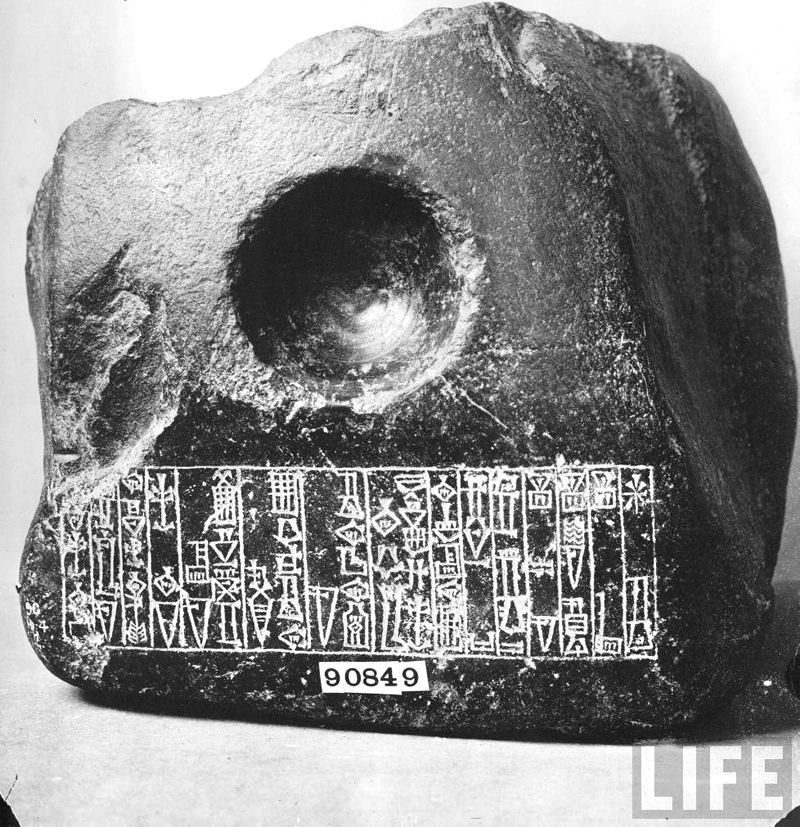 |
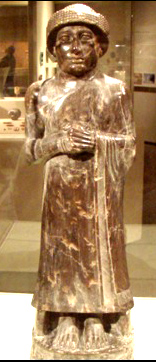 |
Gudea was
succeeded upon the throne of Lagash by his son Ur-Ningirsu, and with this
patesi we may probably establish a point of contact between the rulers of
Lagash and those of Ur. That he succeeded his father there can be no doubt, for
on a ceremonial mace-head, which he dedicated to Ningirsu, and in other
inscriptions we possess, he styles himself the son of Gudea and also patesi of Lagash.
During his reign he repaired and rebuilt at least a portion of E-ninnu, for the
British Museum possesses a gate-socket from this temple, and a few of his
bricks have been found at Tello recording that he rebuilt in cedar- wood the
Gigunu, a portion of the temple of Ningirsu, which Gudea had erected as
symbolical of the Lower World. Moreover, tablets have been found at Tello
which are dated in his reign, and from these we gather that he was patesi for
at least three years, and probably longer. From other monuments we learn that a
highly placed religious official of Lagash, who was a contemporary of Dungi,
also bore the name of Ur-Ningirsu, and the point to be decided is whether we
may identify this personage with Gudea's son.
Ur-Ningirsu,
the official, was high-priest of the goddess Nina, and he also
held the offices
of priest of Enki and high-priest of Anu. Moreover, he was a man
of sufficient
importance to stamp his name upon bricks which were probably
used in the
construction of a temple at Lagash. That he was Dungi's
contemporary is
known from an inscription upon a votive wig and head-dress in
the British
Museum, which is made of diorite and was intended for a female
statuette. The text engraved upon this object states that it was
made by a
certain Bau-ninam for his lady and divine protectress, who was
probably the
goddess Bau, as an adornment for her gracious person, and his
object in
presenting the offering was to induce her to prolong the life of
Dungi, "the mighty man, the King of Ur." The important part of the text
concerns
Bau-ninam's description of himself as a craftsman, or
subordinate official, in
the service of Ur-Ningirsu, "the beloved high-priest of Nina".
From
this passage it is clear that Ur-Ningirsu was high-priest in
Lagash at a period
when Dungi (Shulgi), king of Ur, exercised suzerainty over that
city. If therefore we
are to identify him with Gudea's son and successor, we must
conclude that he
had meawhile been deposed from the patesiate of Lagash, and
appointed to the priestly offices
which we find him holding during Dungi's reign.
The
alternative suggestion that Ur-Ningirsu may have fulfilled his sacerdotal
duties during the lifetime of Gudea while he himself was still
crown-prince, is negatived by the subsequent discovery that during the
reign of Dungi's father, Ur-Engur (Ur Nammu), another patesi, named Ur-abba, was on the
throne of Lagash; for tablets have been found at Tello which are dated in the
reign of Ur-Engur and also in the patesiate of Ur-abba. To reconcile this
new factor with the preceding identification, we must suppose that
Ur-Ningirsu's
deposition
occurred in the reign of Ur-Engur, who appointed Ur-abba as patesi in his
place. According to this view, Ur-Ningirsu was not completely stripped of
honours, but his authority was restricted to the purely religious sphere, and
he continued to enjoy his priestly appointments during the early part of
Dungi's reign. There is nothing impossible in this arrangement, and it finds
support in account-tablets from Tello, which belong to the period of
Ur-Ningirsu's reign. Some of the tablets mention supplies and give lists of
precious objects, which were destined for "the king", "the
queen", " the king's son", or "the king's daughter",
and were received on their behalf by the palace-chamberlain. Although none
of these tablets expressly mention Ur-Ningirsu, one of the same group of
documents was drawn up in the year which followed his accession as patesi,
another is dated in a later year of his patesiate, and all may be assigned with
some confidence to his period. The references to a "king" in the
official account-lists point to the existence of a royal dynasty, whose
authority was recognized at this time in Lagash. In view of the evidence
afforded by Bau-ninam's dedication we may identify the dynasty with that of Ur.
The
acceptance of the synchronism carries with it the corollary that with
Ur-Ningirsu's reign we have reached another turning point in the history, not
only of Lagash, but of the whole of Sumer and Akkad. It is possible that
Ur-Engur (Ur Nammu) may have founded his dynasty in Ur before Gudea's death, but there is
no evidence that he succeeded in forcing his authority upon Lagash during
Gudea's patesiate; and, in view of the comparative shortness of his reign, it
is preferable to assign his accession to the period of Gudea's son. Sumer must
have soon acknowledged his authority, and Lagash and the other southern cities
doubtless formed the nucleus of the kingdom on which he based his claim to the
hegemony in Babylonia. This claim on behalf of Ur
was not
fally-substantiated until the reign of Dungi, but in Sumer Ur-Engur appears to
have met with little opposition. Of the circumstances which led to
Ur-Ningirsu's deposition we know nothing, but we may conjecture that his
acknowledgment of Ur-Engur's authority was not accompanied by the full measure
of support demanded by his suzerain. As Gudea's son and successor he may well
have resented the loss of practical autonomy which his city had enjoyed, and
Ur-Engur may in consequence have found it necessary to remove him from the
patesiate. Ur-abba and his successors were merely vassals of the kings of Ur,
and Lagash became a provincial city in the kingdom of Sumer and Akkad.
CHAPTER X
|






